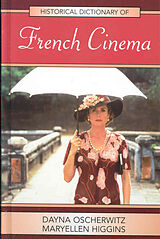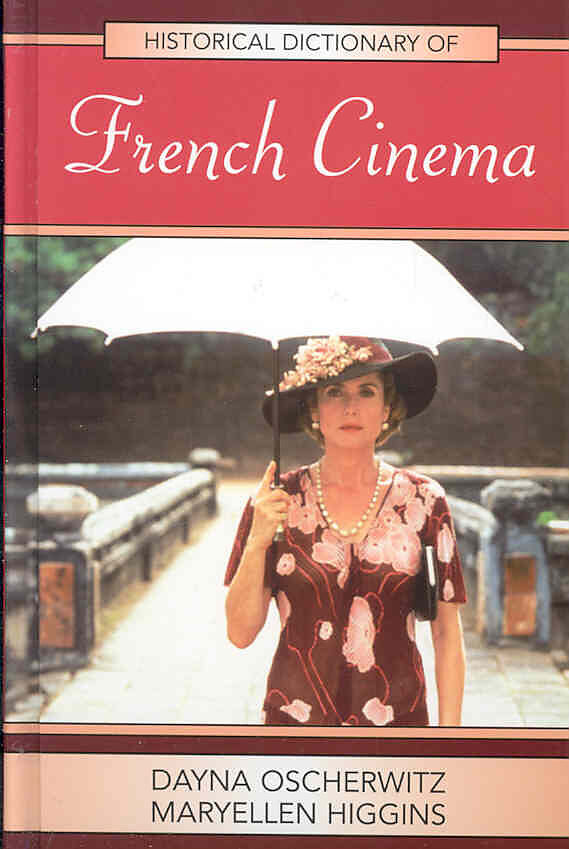Historical Dictionary of French Cinema
Einband:
Fester Einband
EAN:
9780810854918
Untertitel:
Englisch
Autor:
Dayna Oscherwitz, Maryellen Higgins
Herausgeber:
Scarecrow Press
Anzahl Seiten:
502
Erscheinungsdatum:
01.04.2007
ISBN:
0810854910
Informationen zum Autor Dayna Oscherwitz is Assistant Professor of French and Francophone Studies at Southern Methodist University in Dallas, Texas. MaryEllen Higgins is Assistant Professor of Comparative Literature and English at the Greater Allegheny campus of the Pennsylvania State University. Klappentext It can be argued that cinema was created in France by Louis Lumière in 1895 with the invention of the cinématographe, the first true motion-picture camera and projector. While there were other cameras and devices invented earlier that were capable of projecting intermittent motion of images, the cinématographe was the first device capable of recording and externally projecting images in such a way as to convey motion. Early films such as Lumière's La Sortie de l'usine, a minute-long film of workers leaving the Lumière factory, captured the imagination of the nation and quickly inspired the likes of Georges Méliès, Alice Guy, and Charles Pathé. Through the years, French cinema has been responsible for producing some of the world's best directors-Jean Renoir, Jean-Luc Godard, François Truffaut, and Louis Malle-and actors-Charles Boyer, Catherine Deneuve, Gérard Depardieu, and Audrey Tautou.The Historical Dictionary of French Cinema covers the history of French film from the silent era to the present in a concise and up to date volume detailing the development of French cinema and major theoretical and cultural issues related to it. This is done through a chronology, an introduction, photographs, a bibliography, and hundreds of cross-referenced dictionary entries on many of the major actors, directors, films, movements, producers, and studios associated with French cinema. Going beyond mere biographical information, entries also discuss the impact and significance of each individual, film, movement, or studio included. This detailed, scholarly analysis of the development of film in France is useful to both the novice and the expert alike. Inhaltsverzeichnis Part 1 Editor's Foreword Part 2 Preface Part 3 Reader's Note Part 4 Acronyms and Abbreviations Part 5 Chronology Part 6 Introduction Part 7 THE DICTIONARY Part 8 Bibliography Part 9 About the Authors ...
Klappentext
It can be argued that cinema was created in France by Louis Lumière in 1895 with the invention of the cinématographe, the first true motion-picture camera and projector. While there were other cameras and devices invented earlier that were capable of projecting intermittent motion of images, the cinématographe was the first device capable of recording and externally projecting images in such a way as to convey motion. Early films such as Lumière's La Sortie de l'usine, a minute-long film of workers leaving the Lumière factory, captured the imagination of the nation and quickly inspired the likes of Georges Méliès, Alice Guy, and Charles Pathé. Through the years, French cinema has been responsible for producing some of the world's best directors-Jean Renoir, Jean-Luc Godard, François Truffaut, and Louis Malle-and actors-Charles Boyer, Catherine Deneuve, Gérard Depardieu, and Audrey Tautou. The Historical Dictionary of French Cinema covers the history of French film from the silent era to the present in a concise and up to date volume detailing the development of French cinema and major theoretical and cultural issues related to it. This is done through a chronology, an introduction, photographs, a bibliography, and hundreds of cross-referenced dictionary entries on many of the major actors, directors, films, movements, producers, and studios associated with French cinema. Going beyond mere biographical information, entries also discuss the impact and significance of each individual, film, movement, or studio included. This detailed, scholarly analysis of the development of film in France is useful to both the novice and the expert alike.
Inhalt
Part 1 Editor's Foreword Part 2 Preface Part 3 Reader's Note Part 4 Acronyms and Abbreviations Part 5 Chronology Part 6 Introduction Part 7 THE DICTIONARY Part 8 Bibliography Part 9 About the Authors

Leider konnten wir für diesen Artikel keine Preise ermitteln ...
billigbuch.ch sucht jetzt für Sie die besten Angebote ...
Die aktuellen Verkaufspreise von 6 Onlineshops werden in Realtime abgefragt.
Sie können das gewünschte Produkt anschliessend direkt beim Anbieter Ihrer Wahl bestellen.
Loading...
Die aktuellen Verkaufspreise von 6 Onlineshops werden in Realtime abgefragt.
Sie können das gewünschte Produkt anschliessend direkt beim Anbieter Ihrer Wahl bestellen.
| # | Onlineshop | Preis CHF | Versand CHF | Total CHF | ||
|---|---|---|---|---|---|---|
| 1 | Seller | 0.00 | 0.00 | 0.00 |
